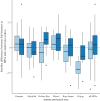Integrating impact evaluation in the design and implementation of monitoring marine protected areas
- PMID: 26460128
- PMCID: PMC4614732
- DOI: 10.1098/rstb.2014.0275
Integrating impact evaluation in the design and implementation of monitoring marine protected areas
Abstract
Quasi-experimental impact evaluation approaches, which enable scholars to disentangle effects of conservation interventions from broader changes in the environment, are gaining momentum in the conservation sector. However, rigorous impact evaluation using statistical matching techniques to estimate the counterfactual have yet to be applied to marine protected areas (MPAs). While there are numerous studies investigating 'impacts' of MPAs that have generated considerable insights, results are variable. This variation has been linked to the biophysical and social context in which they are established, as well as attributes of management and governance. To inform decisions about MPA placement, design and implementation, we need to expand our understanding of conditions under which MPAs are likely to lead to positive outcomes by embracing advances in impact evaluation methodologies. Here, we describe the integration of impact evaluation within an MPA network monitoring programme in the Bird's Head Seascape, Indonesia. Specifically we (i) highlight the challenges of implementation 'on the ground' and in marine ecosystems and (ii) describe the transformation of an existing monitoring programme into a design appropriate for impact evaluation. This study offers one potential model for mainstreaming impact evaluation in the conservation sector.
Keywords: Bird's Head Seascape; Indonesia; conservation impact; coral reefs; counterfactual; monitoring.
© 2015 The Author(s).
Figures


References
Publication types
MeSH terms
LinkOut - more resources
Full Text Sources
Other Literature Sources

